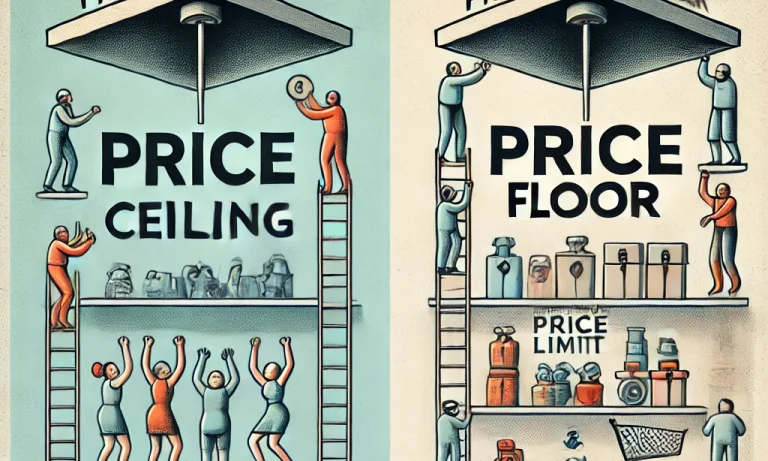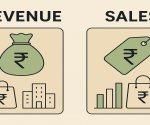Price ceiling and price floor are two concepts of economics and public policy that regulate market prices to achieve equity and stability in the two economies. First, a price ceiling refers to an upper bound on the selling price that makes consumer commodities affordable. In contrast, a price floor, on the other hand, is a minimum price set below the market equilibrium to protect producers. Even though such policies may be good in one sense, they can cause unplanned economic effects by creating shortages or surpluses. Knowledge of their mechanisms, examples, and impacts is important to policymakers, businesses, and consumers.
What is Price Ceiling?
A price ceiling, the legal limit that the government imposes on the amount that would determine the maximum price of goods and services sold, effectively clogs the avenues the sellers use to increase their prices to bring essential commodities within everyone’s reach.
Features of Price Ceiling
- Consumer Protection: It is generally applied to necessities such as food, rent, and medicines to protect consumers from exploitation.
- Below Equilibrium: Normally, the former is higher than the market equilibrium price, where the forces of supply and demand work out to exactly balance each other.
- Market Distortion: Artificially making prices low, a price ceiling disrupts the normal working of the market.
For example, rent controls in urban areas are a common application of price ceilings. While they aim to make housing affordable. They can discourage landlords from maintaining properties or investing in new developments, leading to housing shortages.
What is Price Floor?
A price floor is a minimum price, set and enforced by the government, that must be charged by the seller of the good or service. Unlike a price ceiling, which protects consumers, a price floor protects producers by guaranteeing them a fair price for the products or services they sell.
Features of Price Floor
- Producer Protection: Price floors ensure stable producers’ incomes in unstable markets.
- Above Equilibrium: The price floor is set above the equilibrium price. In this way, it prevents a price level from falling to a certain extent.
- Market Surplus: Whenever a price floor is introduced, the situation is mostly that of excess supply or surplus as the supply exceeds demand.
For example, in agricultural markets, the government often sets a minimum price floor on wheat and rice so that farming costs are covered by farmers. But more often than not, this leads to surplus production that the government needs to buy or subsidize just to stabilize the market.
Price Ceiling vs. Price Floor: Key Differences
Understanding the differences between price ceilings and price floors is vital for grasping their respective roles and impacts on markets.
| Aspect | Price Ceiling | Price Floor |
|---|---|---|
| Definition | Maximum price limit for goods/services. | Minimum price limit for goods/services. |
| Objective | Protect consumers from high prices. | Protect producers’ income. |
| Implementation | Common in housing and healthcare. | Common in agriculture and wages. |
| Impact on Market | This leads to surpluses due to excess supply. | Leads to surpluses due to excess supply. |
| Who Benefits? | Consumers | Producers |
| Examples | Rent control, medicine price caps. | Minimum wage, crop price support. |
| Graph Representation | Below equilibrium price. | Above equilibrium price. |
Economic Impacts
- Price Ceiling Effects: Shortages, lower-quality goods, and black markets since producers will cut down on supply or seek alternative channels for charging higher prices.
- Price Floor Effects: Surpluses, government purchase of surplus goods, and inefficient use of resources due to resources not being fully utilized.
Policy Considerations
Both tools can lead to misallocation of resources if not accompanied by complementary measures, such as subsidies or direct financial support.
Price Floor: Examples
Agricultural Sector
Price floors are widely applied in agriculture to ensure farmers earn a sustainable income despite market volatility. The government establishes a minimum price for crops. Thus, ensuring that the cost of production is covered and a reasonable profit is generated.
- Country: United States
- Product: Corn
- Implementation: The government buys surplus corn or incentivizes exports to manage supply and demand.
- Outcome: Farmers remain financially stable, but taxpayers bear the cost of surplus management.
Minimum Wage
The minimum wage is another prominent example of a price floor. It sets the lowest hourly wage that employers can legally pay workers.
- Country: India
- Sector: Unskilled labor
- Impact: While it ensures fair compensation for workers, a high minimum wage can lead to unemployment as businesses reduce hiring or automate operations.
Difference Between Price Ceiling and Price Floor FAQs
Why are price ceilings and price floors used in the economy?
They are used to stabilize markets, ensure affordability for consumers, and guarantee fair incomes for producers, depending on the need.
What happens if a price ceiling is set above the equilibrium price?
A price ceiling above equilibrium has no effect because the market price is already lower than the ceiling.
How does a price floor cause unemployment?
In labor markets, a price floor like a minimum wage may increase costs for employers, potentially leading to layoffs or reduced hiring.
Can price floors lead to waste?
Yes, in agriculture, surplus goods from price floors can lead to wastage or require costly government intervention for storage and disposal.
What are the drawbacks of price ceilings?
Price ceilings can create shortages, lower the quality of goods, and encourage black markets as producers attempt to circumvent the restrictions.


